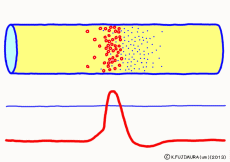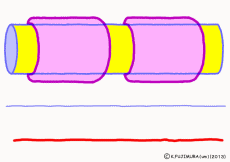[031] Conduction of excitation (GB#113H01) | 基礎医学教育研究会(KIKKEN)Lab

● Electricity is running in the human body
As you are experiencing on a daily basis, electric signals are fast anyway. If you try to convey information quickly among the body, it is best to use electrical signals as well. In nerve and muscle fibers, cells are in the shape of long strings (fibrous) like electric wires, and they use electricity to convey signals to the fibers. However, in reality, the electricity flowing through the cellular material does not reach far in the distance. In the electric appliances around us, electricity is flowing at once by using a copper wire while applying voltage, but another means is required in the body. That is the job of action potential conduction.
–
Contents
- 1 ● Does electricity not travel far in the body?
- 2 ● Conduction of excitation is a message game
- 3 ● Running cell excitation does not turn back
- 4 ● Excitation is transmitted quickly when suppressing leakage of ions
- 5 ● Conduction is faster as the fiber becomes thicker
- 6 ● What is the conduction speed of big animals?
- 7 ○ Referenced sites
- 8 ○ Related articles
- 9 ○ Referenced books
● Does electricity not travel far in the body?
Copper atoms are fixed in the copper wire, only electrons move over it. The number of copper atoms making up the entire copper wire is fixed, and the number of electrons carried by atoms is also fixed. So if you push in some electrons from the edge of the copper wire, the same number of electrons are driven out from the other side. It is not necessary to wait until the electron itself actually entered is moved to the other side. The signal travels far and farther.
On the other hand, in the body, you can not make signal lines compacted with metal atoms like copper wire. It seems that ions with electricity are swimming underwater. Besides, ions in water do not easily exchange electrons.So when an electric signal occurs in a certain place, atoms (ions) with electricity move rather than electrons. But, the ions are much heavier than the electrons and they are big, so they collide with them. Moreover, it got leaked to the side on the way, and the electricity is not transmitted to places far away even if it is several millimeters. When the voltage is made much higher, the ions are forcibly blown and the electricity flows. However, without any meaning, electricity flows only, it can not be used for signals. That is the state of electric shock.
● Conduction of excitation is a message game
Nerve and muscle fibers want to convey signals far away as surely as possible. However, the electric signal of the request is not transmitted at a stretch to far. So, what to do is to partially utilize the nature of the electricity transmitted immediately, and send a signal far away using chain reaction. In these cells, an ion channel that opens and closes in response to electricity is embedded in the entire cell membrane, and its opening and closing is transmitted in a chain reaction.

The first action potential is generated at a place of the cell. The occurrence of action potential is called cell excitation. When the cell is excited, a voltage-dependent sodium channel opens and cationic sodium ions flow from outside the cell across the cell membrane. The inside of the cell membrane is originally in a state of negative electricity called resting potential. It is excited when the membrane potential causes depolarization to a certain extent. The incoming sodium ion becomes an electrical signal and depolarizes to the surroundings, but its effect does not reach the end of the fibrous cell as written above. But that’s enough. Open the reaching range sodium channel and generate a new action potential, then generate an action potential there from and next to it. As such, an open ion channel depolarizes around it to generate an action potential, a new action potential opens its surrounding channels, and the open channel also depolarizes around it. And repeated chain reactions are being transmitted.
Ultimately, when the action potential arrives at the destination, the calcium channel opens additionally, and the increased calcium ion in the cell starts the next work. Excitement conduction is like a messaging game played in a line along a cellular fiber. Here, the voice is an electric signal, and a human corresponds to a channel.
● Running cell excitation does not turn back
When cell excitation occurs, sodium ion flows into the cell, and positive electricity increases in the cell in that part. This depolarizes the surroundings and generates an action potential there, but then the action potential will occur only in places that are not excited just before. In the area just excited, even if depolarization occurs immediately afterwards, action potential does not occur. This is because the ion channel reacting with depolarization has the property that once it is opened, it does not open even when stimulated for a while. In action potential, it does not react for a certain period behind it. This is called the refractory period. Since there is a refractory period, excitation conduction will only proceed forward if it starts once.
In the message game, this message game is slightly different, and the person who heard the message does not sneak out by placing his hand on the ear of the next person. The person who speaks is to repeat what you heard, so that both neighbors can hear it at the same time, but with no more audible voice. However, once a person speaks out, his voice can not be output for a while. In the meantime, even if the person can hear the voice of the neighbor, that person can not make it out. That’s why the message goes only in a certain direction.
This method does not have to worry about which direction the message is conveyed. The person who heard it just repeats what he could hear. Excitement conduction is similar as well, and ion channels do not mind which excitement came from. So, in principle excitement can start with either fiber, which can go to either. This is said in the textbook “the nature of bi-directional conduction of excitement.” Actually, afferent nerve, efferent nerve and so on, the direction in which the signal travels with each fiber is decided in the body, so it might be a slightly confusing term.
After the refractory period, the membrane returns to its original state. Excitement does not leave a trace on the membrane. Therefore, excitation conduction can be repeated any number of times, thousands of times and tens of thousands of times. (Although the actual repetitive message game gets tired soon ….)
● Excitation is transmitted quickly when suppressing leakage of ions
The reason why the electrical signal of the action potential does not reach far is that ions are leaked little by little in the middle of the cell membrane. So if you suppress that leakage, the flow of ions will go far and conduction will proceed faster. In a message game, if you put a pipe that allows easy voice to pass between yourself and the members of both neighbors, you can spread the distance to which the same number of messages are told, so that the speed of the message doubles as a result.

For nerve fibers, there is a method of covering the axon with a pipe that stops the leakage of ions, thereby increasing the conducting distance. Actually, around the axon, another cell makes a structure called myelin sheath, which spreads only the cell membrane and is wound tightly and many times. This nerve fiber is called myelinated nerve fiber. The excitatory conduction of myelinated nerve fibers is many times faster than that of unmyelinated nerve fiber. However, when there is a myelin sheath, the fiber becomes many times thicker, and the number of fibers packed in a limited space decreases, so that myelinated fibers and unmyelinated fibers are properly used depending on the application there.
Then, when wrapped in myelin sheath, the leakage of ions disappears and conduction proceeds fast, but the ions traveling in the axons and outside the fibers are stagnated due to various obstacles this time. So at an interval of absolute safety, there is a gap called “node of Ranvier” in myelin sheath. In myelinated nerve fibers, the action potential is generated only at this node and excitation is transmitted, so this way of transmission is called saltatory conduction.
There is a “demyelinating disease” in which the myelin sheath of myelinated nerve fibers is morbidly dropped out. It is easy to imagine that the conduction velocity slows down as the myelin sheath falls out and becomes an unmyelinated nerve. However, physiologically speaking, since there is no voltage-dependent sodium channel originally under the myelin sheath, the axon that lost myelination afterward should be quite different from the original unmyelinated nerve fiber. Depending on the extent of demyelination, if several blocks of myelin sheath are completely dropped, strong ion flow can not be expected to activate ion channels in the demyelinated tip. It seems reasonable to think that excitement conduction stops halfway. The incompletely damaged portion of the myelin sheath conducts incompletely, so the speed may be slow. In addition, it seems that each myelination sheath is long, the fiber with fast conduction speed is more affected by demyelination, and as a nerve fiber bundle, the conduction velocity is slowed as a whole. I think that the main symptom of demyelinating disease is “paralysis”, not sensory delay or movement delay.
(Addenda) The influence on conduction due to dropping of myelin sheath seems to change with temperature. If the temperature is high, the movement of ions and channels is fast, the conduction is not easily excited and the conduction tends to be oblique, and if the temperature is low it is possible to get excited somehow, but it tends to become excitation conduction with a slow speed. Indeed, in “multiple sclerosis”, a representative of demyelinating diseases, it is known that the neurological symptoms of paralysis worsen as body temperature increases.
● Conduction is faster as the fiber becomes thicker
“Excitement conduction is faster as the fiber is thicker” is a super fundamental subject which certainly comes out to the test. When the fiber becomes thick, when the cross section is seen, the length of the cell membrane becomes longer, but the cross sectional area of the fiber becomes wider by the square thereof. That’s why it is easier for ions to move in the axon, so it’s easier for electric signals to travel far.
So, in fact, how much conduction speed? If you open a nearby textbook, the table of nerve fiber thickness and conduction velocity is almost always listed. As the representative one, the fastest fiber in the body is the motor nerve fiber that moves the skeletal muscle, and the sensory nerve fiber that checks the change in the length of the muscle, it is roughly around 100 m/s. In normal human the fastest peak is roughly 60 m/s when measured with the hands and feet. Both fibers eventually involve skeletal muscle movement, and of course, become myelinated nerve fibers. Because the maximum running speed of human being is about 10 m / sec, its 10 times that, for Olympic-class players, it may be an element that decides the limit of movement soon.
In the late one, unmyelinated fibers per 30 cm/s will be on the table. This is assigned to autonomic nerves which may take some time, and dull pain nerve fibers which deliberately delivers over time. Usually, it is not described in the textbook, but the conduction speed of skeletal muscle fibers (not nerve fibers) seems to be about 3 to 4 m/sec.
● What is the conduction speed of big animals?
By the way, these examples in textbooks are basically data on cats and humans. Roughly speaking, assuming that it is up to 100 m/sec, it is 0.02 sec when the signal is transmitted from the head to the foot when it is almost 2 m in human. This is almost no noticeable conduction time, so there is no problem, but it is 0.3 seconds if it is blue whale with a length of 30 meters. Well, in fact, whale movements are quite slow, so it might be such a thing. However, since conduction velocity of pain fibers is less than half of that of exercise system fibers in humans, if it is so for whales, conduction time seems to be about 0.6 seconds, is it so?
There are more worrisome things about the nerve fibers of big animals. It is a nerve that is also present in humans, but in the branch of the vagus nerve that comes out from the medulla oblongata, there is a peripheral nerve called “recurrent laryngeal nerve”. It dominates the muscles of the throat, swallowing, speaking out. It somehow comes under the aortic arch, just above the heart. It is uselessly wrapping around, and in the case of humans this detour is not so bothersome. But how about the giraffe? When this nerve comes around the heart all the way from the brain, its length is about 12 m. Then, even though giraffe realizes it by swallowing strange things, the muscles of the throat can not react until about 0.2 seconds or less. That’s tough. Anxious such as something on the site below. (However, the main point of the article is that such evil things can not be done if there really is God, so evolution is not a proverb of God ….) In addition, it is written about how the head chief dragon which exceeded 10 m even with the neck alone.
○ Referenced sites
○ Related articles
◆[021] Action potential ![]()
◆[024] Voltage-dependent sodium channel ![]()
◆[028] Resting membrane potential ![]()
◆[040] シナプス伝達 neural signal transmission ![]()
◆[004] Cation and anion, attraction and repulsion ![]()
◆[013] Lipid bilayer of the cell membrane ![]()
◆[041] 心筋線維 myocardial fiber ![]()
◆[044] Stretch reflex ![]()
◆[020] 対光反射 pupillary light reflex ![]()
◆[049] A neural circuit for voluntary movement ![]()
○ Referenced books
・プロッパー細胞生物学: 細胞の基本原理を学ぶ,化学同人
・Essential細胞生物学〈DVD付〉原書第3版,南江堂
・細胞の分子生物学, ニュートンプレス; 第5版 (2010/01)
・肉単―ギリシャ語・ラテン語 (語源から覚える解剖学英単語集 (筋肉編))
・カラー図解 人体の正常構造と機能 全10巻縮刷版,坂井 建雄,日本医事新報社
・人体機能生理学,杉 晴夫,南江堂
・トートラ人体解剖生理学 原書8版,丸善
・イラスト解剖学,松村 讓兒,中外医学社
・柔道整復学校協会編「生理学」,南江堂
・東洋療法学校協会編「生理学」,医歯薬出版株式会社
rev.20140611, rev.20140912,rev.20170505,rev.20170516, rev.20180407.
KISO-IGAKU-KYOIKU-KENKYUKAI(KIKKEN)







